02. Pertinent Information Gathering - A-Division-2021-2022-Odd/Repo-02 GitHub Wiki
INTRODUCTION
Integrating information processing and networking technologies into kinetic sculpture creates new opportunities for exploring the aesthetics of movement and interaction. These technologies enable artists to create sculpture that can receive, store, modify, and transmit information and make possible a new type of work: computational abstractions of living biological systems. These abstractions can be imbued with reflex, affect, and the ability to communicate through combining electrical sensors, digital logic, and communications technology. By using a behavior-based software architecture to control a sculptures movement, complex series of coordinated motion can be performed in response to the sculptures environment and in relation to its internal state. Adding behavior to sculpture changes the interaction between people and the sculptural form. As people directly affect the movement of the sculpture the results of this interaction can be stored by the sculpture and used to modify the course of future interactions and behavior. This provides a foundation for a new dialog between the sculptor, the sculpture, and the audience. [4]
PERTINENT INFORMATION GATHERING
NEED STATEMENT
NK stores is looking for manufacturing of decorative models of kinetic animals to attract the customers.
| Sl no. | Model name | Components | Working principle | Links |
|---|---|---|---|---|
| 01 | Walking dog | Wood Plaque, Grindstone, Rounded Bearings, Nut and Bolts, Strandbeast wiki, Gears, DC motor, Shaft, DC supply, Receiver, Transmitter | Lorentz law, Mechanical advantage | https://youtu.be/SiytvPDcbMs |
| 02 | The bat | DC motor, Cranks, Gears, Shaft, Axle, Liftarm, Link with ball joint sockets, Collar | Lorentz law, Mechanical advantage | https://youtu.be/y2hl8PJm0VI |
| 03 | Walking Dinosaur | Aluminum sheets and wires, Repute pipe, Screw, Nut, String, Pins, Arduino, Arduino UNO board, Haptic device | Pulse width modulation | https://youtu.be/lJWq08FSp5U |
| 04 | Climbing Monkey | Cardboard Sheet, Gears, Glue Gun, DC motor, DC supply, Receiver, Transmitter | Lorentz Law | https://youtu.be/S03Kul3NpdQ |
| 05 | Kinetic Snake | Cardboard box, paper clips, pearl beads, glue, dc motor, reciever circuits, charging module, mobile battery, rc controller | Radio Waves | https://youtu.be/9Wf8_pOIDfQ |
MORE INFORMATION [ MAIN COMPONENTS ]
ARDUINO
Arduino is an open source hardware and software company, project and user community that designs and manufactures single board microcontrollers and micro controller kits for building digital devices. Arduino board designs use a variety of microprocessors and controllers. The boards are equipped with sets of digital and analog input/output (I/O) pins that may be interfaced to various expansion boards ('shields') or breadboards (for prototyping) and other circuits. The microcontrollers can be programmed using the C and C++ programming languages, using a standard API which is also known as the Arduino language, originated from the Processing language.[1]
 [3]
[3]
DC MOTOR
A DC motor is any of a class of rotary electrical motors that converts direct current electrical energy into mechanical energy. The most common types rely on the forces produced by magnetic fields. Nearly all types of DC motors have some internal mechanism, either electromechanical or electronic, to periodically change the direction of current in part of the motor. A DC motor's speed can be controlled over a wide range, using either a variable supply voltage or by changing the strength of current in its field windings. Small DC motors are used in tools, toys, and appliances. The universal motor can operate on direct current but is a lightweight brushed motor used for portable power tools and appliances. Larger DC motors are currently used in propulsion of electric vehicles, elevator and hoists, and in drives for steel rolling mills.[1]
[3]
SERVO MOTOR
A servomotor is a rotary actuator or linear actuator that allows for precise control of angular or linear position, velocity and acceleration.It consists of a suitable motor coupled to a sensor for position feedback. It also requires a relatively sophisticated controller, often a dedicated module designed specifically for use with servomotors.[1]
[3]
TRANSMITTER
Transmitter is an electronic device which produces radio waves with an antenna. The transmitter itself generates a radio frequency alternating current, which is applied to the antenna. When excited by this alternating current, the antenna radiates radio waves.[1]
 [3]
[3]
RECIEVER
A receiver is an electronic device that receives radio waves and converts the information carried by them to a usable form. It is used with an antenna. The antenna intercepts radio waves (electromagnetic waves) and converts them to tiny alternating currents which are applied to the receiver, and the receiver extracts the desired information. The receiver uses electronic filters to separate the desired radio frequency signal from all the other signals picked up by the antenna, an electronic amplifier to increase the power of the signal for further processing, and finally recovers the desired information through demodulation.[1]
Bibliography
- Wikipedia
- Youtube
- Pintrest
- MIT Journal